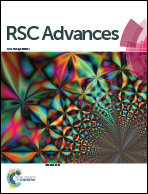Synthesis and property of a Helwingia-structured nickel nitride/ nickel hydroxide nanocatalyst in hydrazine decomposition†
Abstract
Unique Helwingia-structured nickel nitride nanoparticles on nickel hydroxide nanosheets (H–Ni3N/Ni(OH)2) were prepared using hydrothermal synthesis of Ni(OH)2 nanosheets followed by partial phase transformation to Ni3N via controlled nitridation. The H–Ni3N/Ni(OH)2 was characterized for its structural information and studied for catalytic properties. It exhibited both good activity and excellent stability in aqueous phase and low temperature hydrazine decomposition, demonstrating its potential as a catalyst for the reaction. Mechanisms behind the catalytic property of the H–Ni3N/Ni(OH)2 structure were discussed based on careful kinetics studies and characterizations.


 Please wait while we load your content...
Please wait while we load your content...